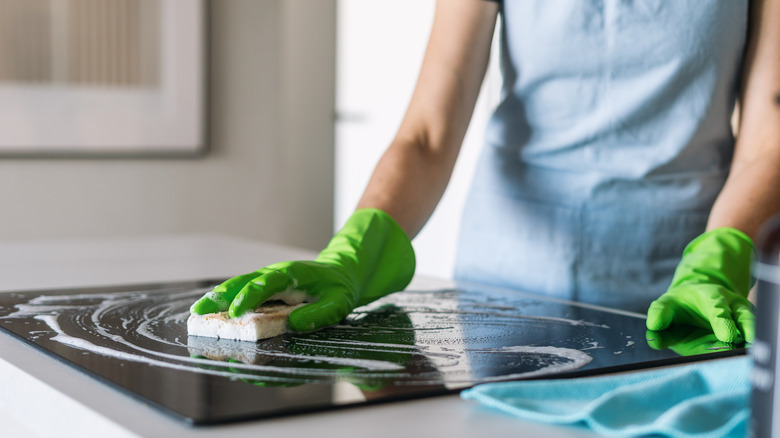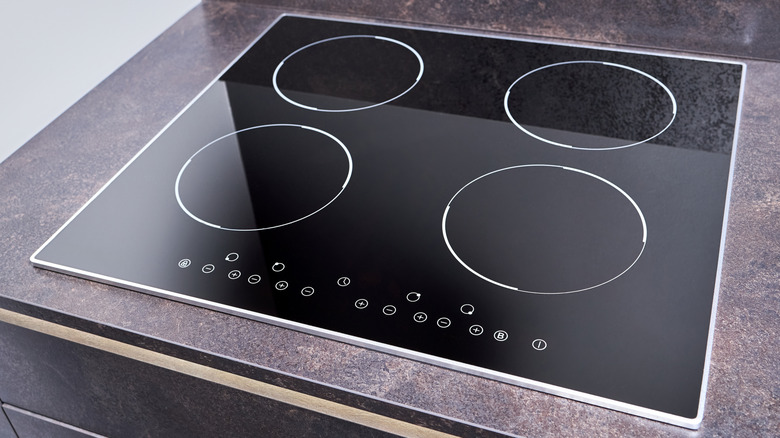Read This Before Cleaning A Glass Stovetop With A Magic Eraser
We may receive a commission on purchases made from links.
Mr. Clean Magic Erasers are an essential part of many cleaning routines. Regular sponges are great, but they don't hold the same scrub power as the melamine foam of a Magic Eraser. From bathtubs to walls, this sponge can help clean up a variety of messes, like grime, soap scum, and even permanent marker. Many homeowners keep this tool in their kitchen to help clean up food messes, especially from their glass stovetops. Luckily, your glass stovetop isn't one of the surfaces in your home to avoid using a Mr. Clean Magic Eraser, but you should use caution if you have a stuck-on mess.
The cleaning power of a Magic Eraser comes from the melamine foam — this material acts like a fine sandpaper, using tiny, hard micro-scrubbers to lift and scrape away debris with water alone. This means that scrubbing too hard or using too much pressure to clean could actually lead to a dull or scratched finish on your cooktop. Before using a Mr. Clean Magic Eraser on your glass stovetop, assess the mess. If it's a light buildup, simply wetting the eraser and wiping gently should be enough to lift the stain without causing scratches. Make sure you thoroughly wet the eraser and test in an inconspicuous area first. Rub with a light and gentle touch, avoiding excessive pressure, then wipe down the surface with a clean, damp cloth afterward. For a more significant, stuck-on mess, you should first try safer, non-abrasive methods instead to avoid ruining your glass stovetop.
The best methods for cleaning your stovetop
While you can reach for the Magic Eraser for a small spot of mild grime, there are other easy ways to clean glass stovetops that won't result in potential damage. First, instituting a daily maintenance schedule for small messes helps prevent tough, stuck-on spills and splatters. After making sure your glass stovetop is cool, use a soft cloth with a small amount of dish soap and warm water, or a spray of vinegar and water (1:1 ratio) to quickly wipe away everyday spills and grease. When done, dry with a clean microfiber cloth to prevent streaks.
If you have tougher messes or even light marks, you'll want to break out a dedicated cooktop cleaner, like Weiman Cooktop and Stove Top Cleaner Kit. These cleaners are specially designed to clean without scratching, keeping your cooktop shiny and protected. With these, you'll want to follow the directions on the back of the bottle, but most follow the same procedures. Apply a dime-sized amount onto the cool surface, and scrub with a non-abrasive cooktop pad or a non-scratch sponge in a gentle circular motion. When done, wipe away the residue with a damp cloth, then buff with a clean, dry microfiber cloth.
For super complex messes, you can use an affordable item to clean your glass stovetop, like WD-40. However, you must take extreme caution and thoroughly clean all oily residue with soap and water afterward to prevent fire or contamination when you use the stovetop again. For a safer alternative, consider using baking soda paste and a hot towel to loosen the stubborn grime. Even though the baking soda is mildly abrasive, it's not as harsh as the Magic Eraser melamine foam, making this a better choice for minimal damage.

